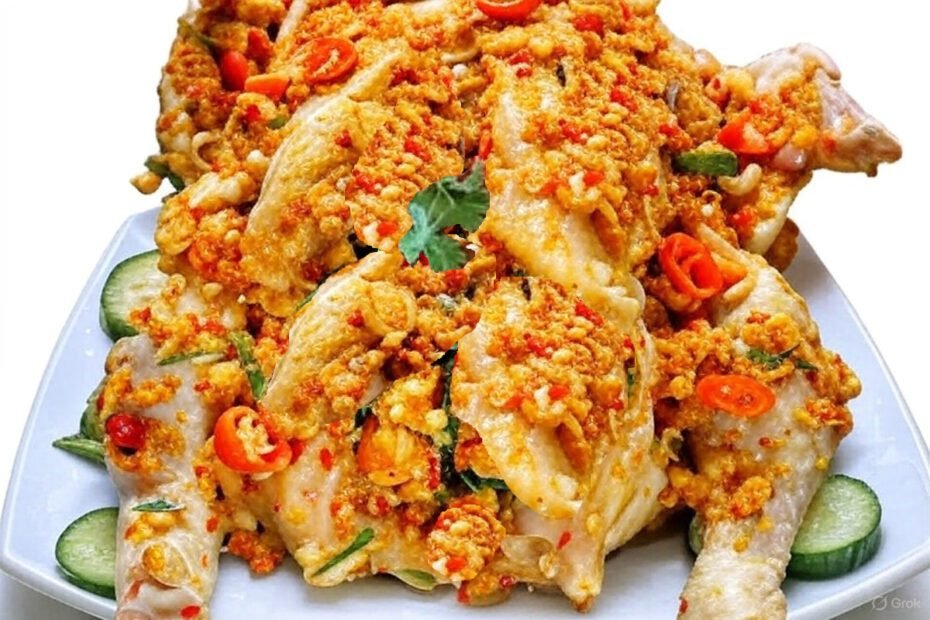By Ayisha Khatun ( A student and poet) Guest post
I am Aisyah, a 26-year-old Muslim woman living in a small village near Ubud, Bali. Many people know Bali as a tourist island with beaches and temples. But for me, Bali is home. I was born here, in a family that loves food, prayer, and tradition. I wear my hijab proudly, and I love my island with all its colors — including the kitchen colors: red chili, green leaves, golden turmeric, and brown roasted chicken.
One of the dishes I hold close to my heart is Ayam Betutu — a traditional Balinese spiced chicken, cooked slowly until tender, full of rich flavor and aroma. My nenek (grandmother) taught me this dish when I was a teenager. She always said, “Masakan dari hati, bukan hanya dari dapur.” (Food must come from the heart, not just the kitchen.)
Ayam Betutu is usually made for special occasions — ceremonies, weddings, or big family gatherings. But in my house, we make it on Sundays or during Lebaran (Eid), when everyone is home and the air smells like shallots and lemongrass.
This is my story, and I want to share this dish with you — from my kitchen in Bali, with love and simplicity.
What is Ayam Betutu?
Ayam Betutu is a whole chicken (ayam utuh) marinated and stuffed with a rich blend of Balinese spices, then roasted or steamed for hours. The word “betutu” comes from “tutu”, which means to burn or roast slowly. Traditionally, the chicken is wrapped in banana leaves and slow-cooked in coal or underground fire pits. These days, we often use steamers or ovens — but the heart of the dish remains the same: bumbu Bali, the spice paste that makes everything magical.
For Muslims like me, we adapt the recipe to keep it halal, using no pork or alcohol, and we always prepare it with care and cleanliness. My family uses kampung chicken (free-range), which makes the flavor even deeper.
Traditional Ayam Betutu Recipe (Simple Home Version)
This recipe serves 4–6 people. You can use a whole chicken or chicken pieces if you prefer.
Ingredients
Main:
- 1 whole chicken (about 1.2–1.5 kg), cleaned
- Juice of 1 lime
- Salt to rub the chicken
Spice Paste (Bumbu Betutu):
- 10 shallots
- 5 garlic cloves
- 5 red chilies (adjust to taste)
- 3 candlenuts (kemiri)
- 1 thumb fresh turmeric (or 1 tsp turmeric powder)
- 1 thumb ginger
- 1 thumb galangal
- 2 tsp coriander seeds
- 1 tsp black peppercorns
- 1 tsp nutmeg powder
- 1 tsp cumin
- 1 tsp shrimp paste (optional – check for halal if needed)
Aromatics:
- 2 lemongrass stalks, bruised
- 5 kaffir lime leaves
- 2 salam leaves (Indonesian bay leaf)
- Banana leaves or foil (for wrapping)
Oil for sautéing
Step-by-Step Cooking Method
1. Clean and prep the chicken:
Rub the chicken with lime juice and salt. Let it sit for 10–15 minutes to remove any smell. Rinse well and pat dry.
2. Make the spice paste:
Blend all the bumbu (spice paste) ingredients into a thick, smooth paste. Add a little oil or water if needed to blend easily.
3. Sauté the spice paste:
Heat 2–3 tablespoons of oil in a pan. Sauté the spice paste on medium heat for about 8–10 minutes until fragrant and slightly darker in color. This step brings out all the aroma.
4. Stuff and rub the chicken:
Take some of the spice paste and stuff it into the chicken cavity. Rub the rest all over the chicken — under the skin if possible. Add bruised lemongrass, kaffir lime leaves, and salam leaves inside the chicken or around it.
5. Wrap the chicken:
Traditionally, we use daun pisang (banana leaf), but you can also use foil. Wrap the chicken tightly to keep the moisture in.
6. Steam the chicken:
Place the wrapped chicken in a steamer and steam for 1.5 to 2 hours until the chicken is very tender. You can also bake it in the oven at 180°C (350°F) for 2 hours.
7. Optional final roast:
After steaming, you can unwrap the chicken and roast it in the oven or pan-fry it for 10–15 minutes to get a slightly crispy skin. This is not always necessary, but adds a nice touch.
Serving Suggestions
Serve Ayam Betutu with:
- Nasi putih (steamed rice)
- Sambal matah (raw shallot-chili sambal, if you like spice)
- Steamed vegetables or urap (vegetables with grated coconut)
- A cup of hot tea or fresh lime juice
We usually eat together on the floor, sharing stories while the kids pick the tender meat with their fingers. It’s not just dinner — it’s memory-making.
Why Ayam Betutu Is Special to Me
When I cook this dish, I feel close to my nenek, who passed away three years ago. I remember her hands — strong, wrinkled, always full of turmeric and love. She never used exact measurements, only feelings and smell. “Masak dengan ikhlas, nanti rasa akan ikut.” (Cook with sincerity, and the taste will follow.)
Now, I teach my younger sister the same way. We laugh, we cry, we taste. Sometimes, we make this dish for pengajian (Islamic gatherings) or for neighbors when someone is sick or celebrating. Sharing food is part of our adat (tradition), and Ayam Betutu is always welcomed.
For me, it is not just Balinese food. It is my story, my roots, my prayer — wrapped in spice, steamed with love, and served with warmth.
If you ever visit Bali, don’t just eat Ayam Betutu in a restaurant. Try making it at home, and remember — food is not only for the stomach. It is for the heart. Dari hati ke hati. From heart to heart.
